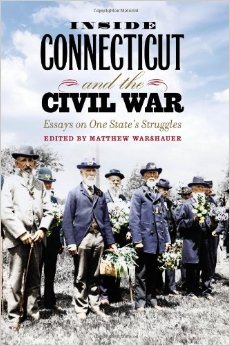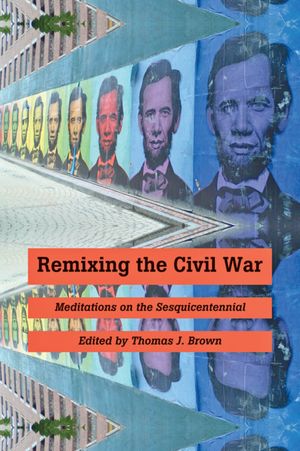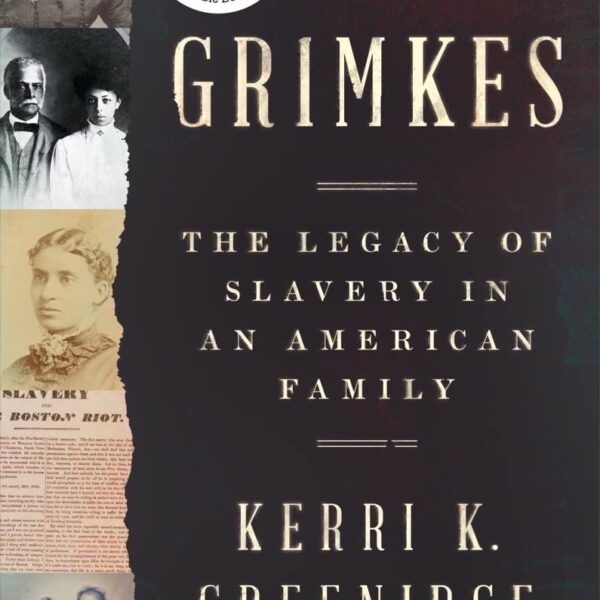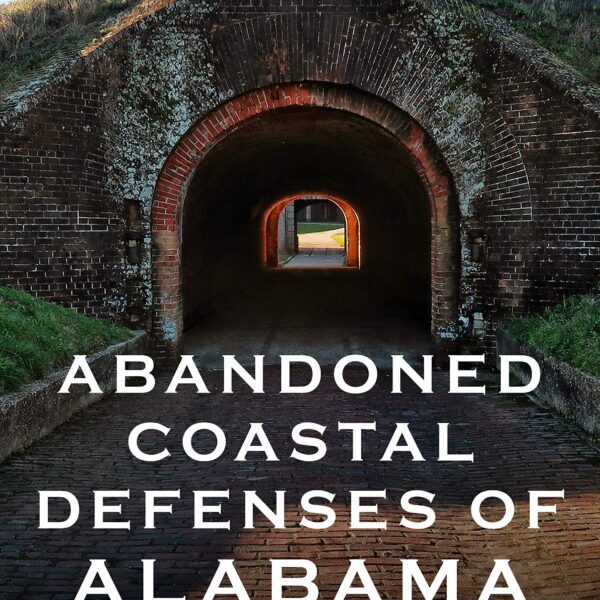Inside Connecticut and the Civil War: Essays on One State’s Struggles edited by Matthew Warshauer. Wesleyan University Press, 2014. Paper, ISBN: 978-0-81957396-4. $27.95.
 In his brisk introduction, editor Matthew Warshauer applauds the excitement with which the state of Connecticut has embraced the Civil War sesquicentennial. In conjunction with the Connecticut Civil War Commemoration Commission, a host of Civil War Roundtables, re-enacting units, historical societies, and local libraries have sponsored lectures, public programs, and other commemorative activities to shed light on Connecticut’s role in the conflict – a role often overshadowed by seemingly more influential neighbors like New York and Massachusetts. Though the issue of slavery is poised squarely at the center of the sesquicentennial narrative, Warshauer rightly admits that Connecticut has too often viewed itself as far removed from the institution of slavery. “Connecticut residents are shocked to learn,” Warshauer explains, “that their state was not the bastion of abolitionist liberalism that they had always assumed” (2).
In his brisk introduction, editor Matthew Warshauer applauds the excitement with which the state of Connecticut has embraced the Civil War sesquicentennial. In conjunction with the Connecticut Civil War Commemoration Commission, a host of Civil War Roundtables, re-enacting units, historical societies, and local libraries have sponsored lectures, public programs, and other commemorative activities to shed light on Connecticut’s role in the conflict – a role often overshadowed by seemingly more influential neighbors like New York and Massachusetts. Though the issue of slavery is poised squarely at the center of the sesquicentennial narrative, Warshauer rightly admits that Connecticut has too often viewed itself as far removed from the institution of slavery. “Connecticut residents are shocked to learn,” Warshauer explains, “that their state was not the bastion of abolitionist liberalism that they had always assumed” (2).
Serving as a useful companion to Warshauer’s Connecticut in the American Civil War: Slavery, Sacrifice, and Survival [Wesleyan University Press, 2011], this nine essay anthology continues to probe the “essential role this little New England powerhouse played” during the American Civil War (2). The project of a handful of talented graduate students at Central Connecticut State University, Inside Connecticut and the Civil War touches upon topics ranging from the state’s little-known role in financing the war to its early efforts at commemoration; from the crucial war ships sailing south out of Mystic Seaport to the psychological trauma of the battlefield that followed veterans home to the Nutmeg State.
The lead essay, “Guns and Butter: How Connecticut Financed the Civil War,” tackles the less-than-glamorous topic of the state’s fiscal obligations during wartime. In an effective, year-by-year breakdown of Connecticut Governor William Buckingham’s efforts to keep his state solvent amidst soaring financial demands, author James E. Brown argues that, “Connecticut officials faced many of the same public policy demands that President Lincoln and Congress dealt with on the national level” (6). Whether on the state level or national stage, politicians had to determine how high they could raise taxes on their residents, “all while minimizing conflict and dissention and assuring broad-based support for the war effort” (6). Brown’s essay transitions easily into Diana Moraco’s piece on Mystic’s critical shipbuilding efforts for the Union navy. Second only to Boston in its production of navy ships, the shipbuilders of Mystic (cleverly negotiating and securing dozens of government contracts and subcontracts) would eventually supply the Union navy “with some fifty-seven steam vessels for the Union war effort,” including notable ships like the Stars and Stripes, the Varuna, the Albatross, and the ironclad warship USS Galena.
Moraco likens the fervor with which the government turned to Mystic for its warships to the intense demand placed on Hartford’s famous Colt Armory for the manufacture of firearms – the subject of Luke G. Boyd’s essay, “The Colt Armory Fire: Connecticut and the Great Confederate Conspiracy.” When the famed Patent Firearms Company complex went up in flames on February 5, 1864 (very likely a disaster without sinister causes), the state of Connecticut leapt immediately to the idea of a Confederate conspiracy—a “symptom,” Boyd explains, of the era’s “paranoia and [the] ever-present fear of Confederate invasion and sabotage” (140). Boyd’s article sheds light on how the fanatical conspiracy theories surrounding fire at the Colt Armory (and the subsequent campaigns to see the structure re-built) actually reinvigorated Connecticut’s waning support for the war effort. But even while many in the state may were war-weary by 1864, Carol Patterson-Martineau’s case study of patriotism and abolitionism in Windham County, Connecticut, argues that Windham’s Revolutionary War legacy and long history of abolitionism may help to explain the county’s consistent “resounding Unionism” throughout the war (69). While acknowledging that Windham County is unique and does not reflect upon the state at large, she presents a convincing case for the factors that came together to form a particularly passionate pro-Union county. Furthermore, the essay highlights the need for more case studies on the state and local level.
No discussion of a state’s involvement in the Civil War would be complete without an extended examination of the rank and file. David C.W. Batch offers an analysis of what was arguably the “most battle-hardened unit from the state”: the 14th Connecticut Volunteers (101). Batch describes their war service, from their baptism-by-fire at Antietam to their participation in Robert E. Lee’s surrender at Appomattox Court House. A regiment composed of “untried” enlistees hailing from eighty-six different Connecticut towns, they would muster out on May 31, 1865, “claiming three Congressional Medal of Honor winners” among their ranks (132). Yet the trauma they encountered on the battlefield mercilessly trailed many of the men of the 14th and other Connecticut regiments back to their home state. This is the subject of Michael Sturges’s piece on Post-Traumatic Stress Disorder (PTSD). While Sturges is overly quick to diagnose Civil War veterans with modern-day psychiatric language, he makes great use of post-war census data, pension records, and patient files from the Connecticut Hospital for the Insane to illustrate the depth (and persistence) of psychological trauma among Connecticut’s veterans. Nineteenth-century physicians turned to diagnostic language that was “still steeped in ancient understandings” of the human mind and body (175). They utilized general terms like “nostalgia,” “nervous hysteria,” “melancholia,” “nervous disease,” and “insanity” when describing afflicted veterans; only in the decades after the war did they consistently acknowledge that this behavior was directly related to veterans’ wartime experiences (172).
Even while many veterans struggled with the psychological scars of war, the state engaged in commemorative activities. Todd Jones’s biographical essay explores the role of General Joseph R. Hawley, a beloved former general, statesman, and advocate for his state’s veterans. An instrumental force in the construction of multiple monuments throughout the state (including the Hartford Soldiers’ and Sailors’ Memorial Arch), veterans clearly understood that “Hawley was a man to turn to when [they] wanted to construct a monument” (185). Jones’s essay transitions into a broader examination of the state’s commemorative history in Emily Gifford’s piece, “From Dedication Day to the Centennial Commission.” Gifford surveys the course, consequences, and underlying motivations of various generations of commemoration. Her primary focus lands on the centennial. While “the national centennial efforts became littered with tchotchkes and hurt feelings,” she argues that the state of Connecticut “chose a different path in its pursuit of the Civil War centennial commemoration” in which its centennial commission “pursue[d] serious academic research” while simultaneously promoting “public interest in the Civil War” (214-215).
The book concludes with an essay examining modern re-enactors in Connecticut. Author Michael Conlin concludes that “there is a divide between reenactors in Connecticut and modern academic scholars” (249). Conlin notes that while reenactors display a genuine interest in educating the public at large, their focus remains largely on the military aspects of the war.
Taken together, the essays in this anthology attempt to move beyond John Niven’s classic work, Connecticut for the Union: The Role of the State in the Civil War [1965]; they tackle a host of under-studied subjects in the state’s history, shedding light on integral facets of Connecticut’s relationship to the Civil War. While at times the book seems to lack focus, this is an incredibly useful volume—one that shows what tenacious research in local libraries and archives can yield about larger historical themes.
Allison Jordan, a native of Connecticut, works for the Civil War Institute at Gettysburg College and serves as Visitor Services Manager at Drayton Hall.



